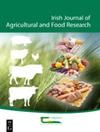冬大麦黄矮病毒防治药剂施用时机与产量的评价
IF 1.4
4区 农林科学
Q3 AGRICULTURE, MULTIDISCIPLINARY
引用次数: 0
摘要
大麦黄矮病毒(Barley yellow dwarf virus, BYDV)是世界范围内重要的粮食作物病毒性病害,也是造成产量损失的主要原因。BYDV感染的危险期与较温和的温度相吻合,这延长了蚜虫的飞行时间,并促进了病毒通过作物中初级和次级蚜虫的运动传播。次生蚜虫运动与冬季谷物中更大的BYDV传播有关。因此,BYDV管理的一个关键组成部分是延迟冬季谷物的播种和正确的杀虫剂施用时间,以最大限度地保护作物。爱尔兰以前的研究考虑在播种谷物的早期(9月)和后期(10月以后)施用杀虫剂。早期的研究没有考虑温度、蚜虫飞行和二次传播风险的作用阈值。本研究旨在了解在10月播种冬大麦时施用杀虫剂的最佳时机,以减少BYDV感染和产量影响。将3°C的临界温度作为蚜虫发育的阈值,从而导致蚜虫的移动和BYDV的传播,并根据温度的可预测间隔对作物施用杀虫剂。结果表明,喷施时间、地点和年份对青枯病症状和产量均有影响,但仅对青枯病症状的减少有显著影响。就BYDV症状和产量而言,未经处理(对照)地块与“早”和“晚”施用杀虫剂之间存在显著差异,而且对BYDV症状的影响比产量更显著。这项工作表明了优化单一杀虫剂喷雾控制十月播种谷物的价值,并为谷物作物管理决策提供了支持。本文章由计算机程序翻译,如有差异,请以英文原文为准。
Evaluating the timing of insecticide application to manage barley yellow dwarf virus and yield in winter barley
Barley yellow dwarf virus (BYDV) is an important viral disease of grain crops worldwide and a major cause of yield loss. The risk periods for BYDV infection coincide with milder temperature that prolongs aphid flight and facilitates viral transmission through primary and secondary aphid movement in the crop. Secondary aphid movement is associated with greater BYDV spread in winter cereals. A critical component of BYDV management is therefore delaying sowing of winter cereals and correctly timing insecticide application to maximise crop protection. Previous research in Ireland considered insecticide timing in early (September) and late (October onwards) sown cereals. Early research did not consider action thresholds around temperature, aphid flight and risk of secondary spread. This research set out to understand the optimal timing of insecticide application in October sown winter barley to reduce BYDV infection and yield impact. A critical temperature of 3°C was used as a threshold for aphid development that leads to movement and BYDV spread, and insecticide treatments were applied to the crop at predictable intervals in relation to temperature. Results show that BYDV symptoms and yield are affected by spray time, location and year, although only significant with regard to the reduction of BYDV symptoms. For both BYDV symptoms and yield, there was a significant difference between untreated (control) plots and “early” and “late” applications of insecticide, again more notable for BYDV symptoms than yield. This work indicates the value of optimising a single insecticide spray for control of October sown cereals and supports decision-making in the management of cereal crops.
求助全文
通过发布文献求助,成功后即可免费获取论文全文。
去求助
来源期刊
CiteScore
2.50
自引率
20.00%
发文量
23
审稿时长
>36 weeks
期刊介绍:
The Irish Journal of Agricultural and Food Research is a peer reviewed open access scientific journal published by Teagasc (Agriculture and Food Development Authority, Ireland). Manuscripts on any aspect of research of direct relevance to Irish agriculture and food production, including plant and animal sciences, food science, agri environmental science, soils, engineering, buildings, economics and sociology, will be considered for publication. The work must demonstrate novelty and relevance to the field of research. Papers published or offered for publication elsewhere will not be considered, but the publication of an abstract does not preclude the publication of the full paper in this journal.

 求助内容:
求助内容: 应助结果提醒方式:
应助结果提醒方式:


